What are the best squash strings on the market today? In this article I’ll do my very best to answer that question and also answer a few common questions about squash strings.
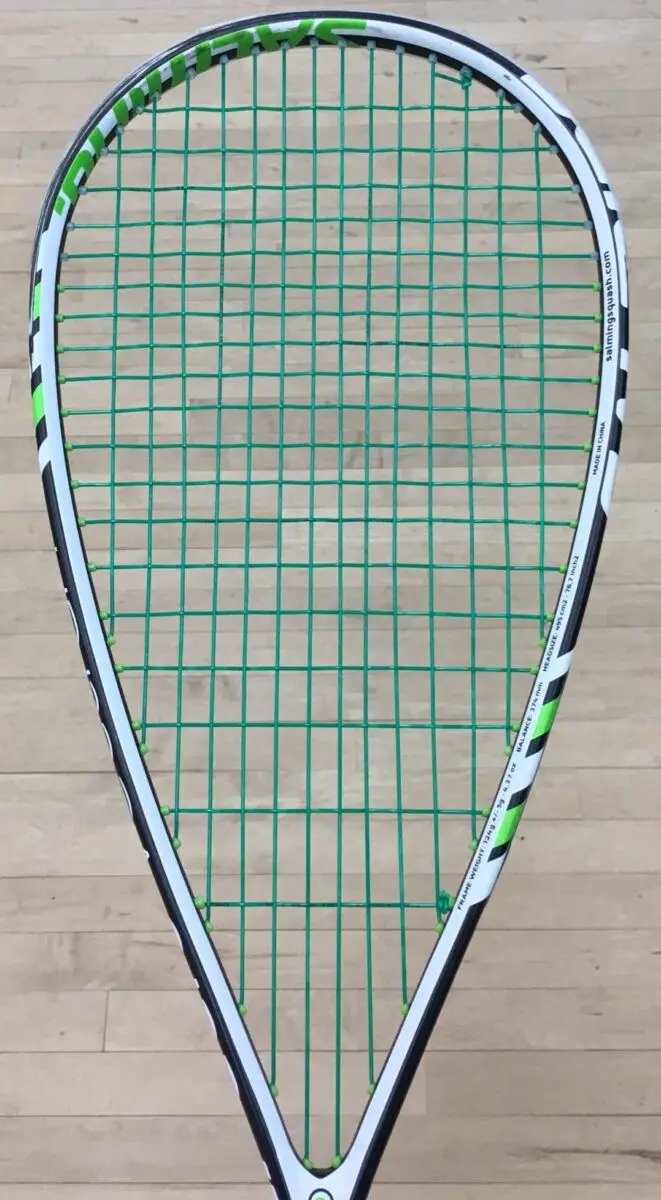
- What are the best squash strings?
- What are squash strings?
- Is it worth restringing a squash racket?
- What strings and tensions do pro squash players use?
- What tension should I string my squash racket?
- What is the factory string tension of my squash racket?
- How much does it cost to restring a squash racket?
What Are the Best Squash Strings?
I’ll start with a rundown here of some squash strings that I personally liked. To be honest I like a lot of different squash strings so don’t be afraid to experiment, and don’t be afraid to ask your local stringer their thoughts about what will suit your game and/or what they have in stock!
Tecnifibre X-One Biphase
Pure Power
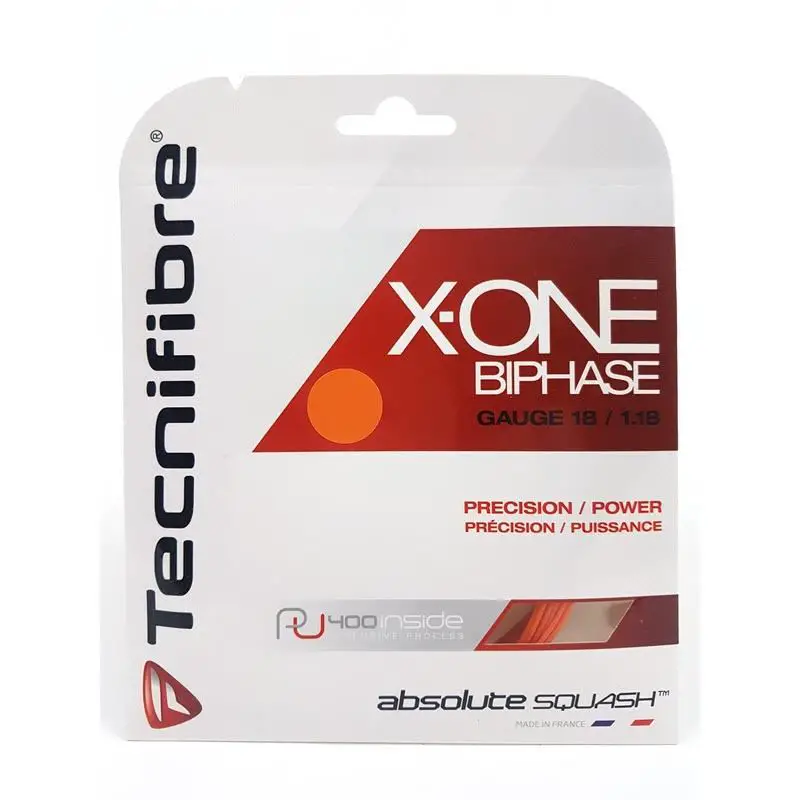
Image via qss-squash.nl
Product Info
Price: $20
Affiliate Links
Squash Source receives a commission when you buy through these links. Thanks!
Buy (US): amazon.com | squashgalaxy.com | squashgear.com
Search:I tried this Tecnifibre string about a year ago and thought it was probably the most powerful string I’d ever used. I tested at a tension of 25 pounds. This also had the benefit of improving my control, once I learned to harness it with a shorter backswing. These are 18 gauge / 1.18 mm (more on string gauges later in the article) and the current version of these are an orange color, although a prior version came in red.
Ashaway SuperNick ZX Micro
Balanced Attack
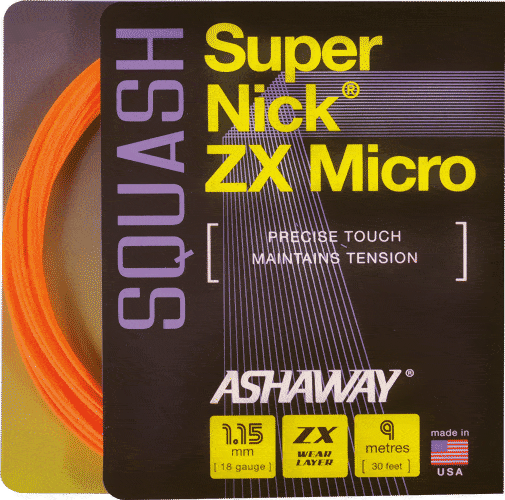
Product Info
Price: $12.75
Affiliate Links
Squash Source receives a commission when you buy through these links. Thanks!
Buy (US): holabirdsports.com | squashgalaxy.com | squashgear.com
Search:These, like other Ashaway strings, have a little more grit to them, which gives you the ability to put a bit of “cut” or spin on your shots. These strings felt maybe a touch less powerful than the X-One Biphase, but a little bit more control out of the box. These are a little thinner (and thus a bit less durable) at 18 gauge / 1.15 mm.
Tecnifibre DYNAMIX VP
Quality and Durability
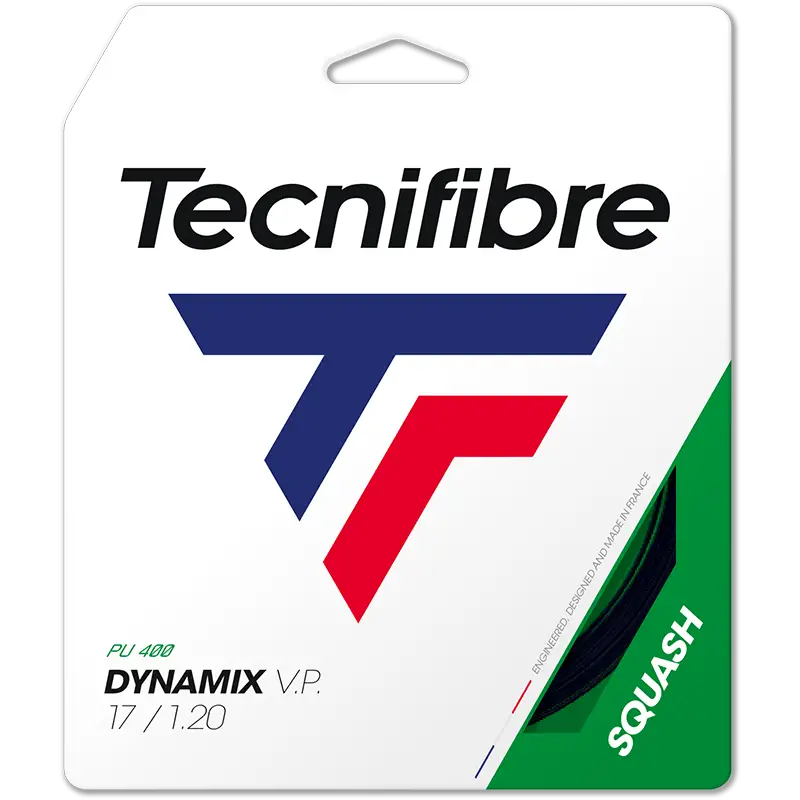
Affiliate Links
Squash Source receives a commission when you buy through these links. Thanks!
Buy (Canada): controlthet.com
Buy (US): holabirdsports.com | squashgear.com
Search:This one’s another good blend of power and control that also has good durability. This comes in three different sizes and I’d recommend the middle size, which is 17 gauge / 1.20 mm. Currently Tecnifibre’s top-of-the-line rackets are factory strung with this brand of string, except they use the slightly thicker “17L” / 1.25 mm version. Personally I think if you’re going to restring it’s worth sizing down to the 1.20 mm.
Ashaway SuperNick XL
Budget Pick
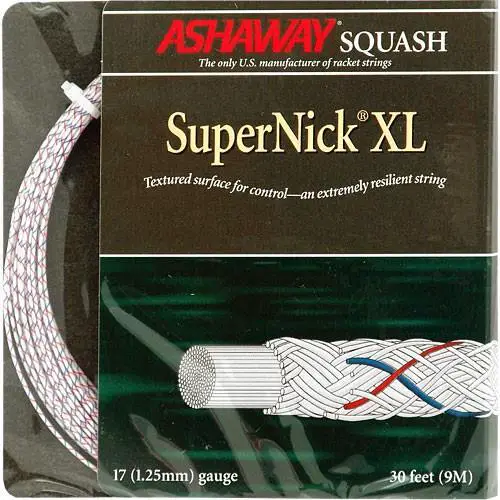
Product Info
Price: $12
Affiliate Links
Squash Source receives a commission when you buy through these links. Thanks!
Buy (Canada): controlthet.com | racquetguys.ca
Buy (US): holabirdsports.com | racquetguys.com | squashgalaxy.com | squashgear.com
Search:Gonna be honest, I haven’t used this since college but it was NICE 👌 back in the day. I remember it being soft and having good grit. The knock on this today is it’s lacking in feel and crispness compared to some newer strings. At 1.25mm (17 gauge) it’s a bit thicker and more durable. I put it on the list because it’s a budget pick but still a classic.
Tecnifibre 305
Pro Favorite
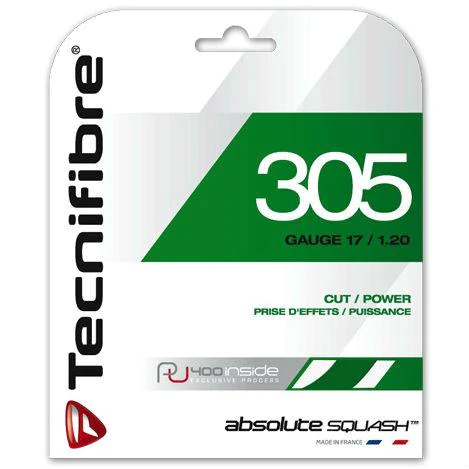
Product Info
Price: $16
Affiliate Links
Squash Source receives a commission when you buy through these links. Thanks!
Buy (Canada): racquetguys.ca | racquet-science.com
Buy (France): amazon.fr
Buy (Germany): amazon.de
Buy (US): amazon.com | holabirdsports.com | racquetguys.com | squashgalaxy.com | squashgear.com
Search:The deal with this one is it’s used by a whopping number of pro players. If you watch pro squash you’ll see this telltale green string in lots of rackets. Apparently the top players feel this string really gives them a lot of “bite” — another euphemism for imparting spin on the ball. The knock on these is they’re not considered very durable. I tried these strings once a few years ago and liked them, but the strings lasted me about 5 months before breaking on an off-center hit. I’m not a particularly hard hitter so that was a pretty short outing for me as far as strings go.
Python Atlas Deluxe
Reel Steal
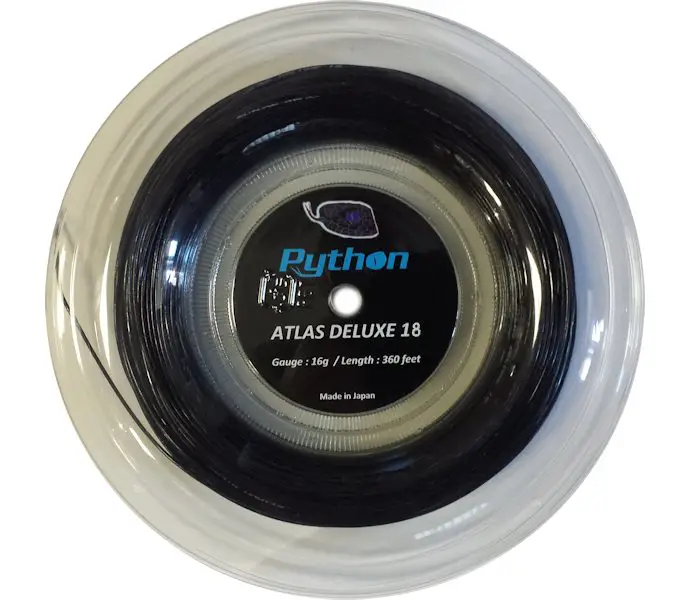
Product Info
Price: $80
Affiliate Links
Squash Source receives a commission when you buy through these links. Thanks!
Buy (US): squashgalaxy.com
Search:For stringing my own rackets at home (I have a small stringing machine), I bought myself a reel of Python Atlas Deluxe 18 gauge. This is only available at Squash Galaxy in the US. The feel is decent and the durabilty has been good. It’s an absolute steal at just $80 for the reel.
What Are Squash Strings?
Squash strings are an under-emphasized piece of squash equipment. Most people spend tons of time and money deciding on a squash racket, forgetting that it’s the squash strings that actually make contact with the ball.
And I must admit, I’ve been that guy on occasion. Even to this day, I spend more time thinking about the weight and balance of my squash racket than I do about my squash strings. But both are important and really they should be given equal consideration.
Factory Strings
When you buy a squash racket, the strings it comes with are called the factory strings.
They are often mediocre.
But if you think about it, it’s understandable.
Consider it from the perspective of the racket manufacturers. They want to sell products for the masses. And the masses typically want just a durable, everyday string. They don’t want or need to spend a ton of extra money on high end strings.
When it comes to factory strings, manufacturers tend to prioritize two things: durability and price. They want people to be able to use the racket right out of the box, but without adding too much to the cost of the racket. The strings also need to last a while, or racket buyers will be upset.
Performance Squash Strings
While factory strings emphasize durability and affordability, premium squash strings place the focus squarely on performance. This means you can often improve both power AND control by upgrading your squash strings.
Premium strings are made of higher quality materials and more modern manufacturing techniques. A nice new set of strings can make your power shots feel more crisp while simultaneously giving you better feel on your touch shots.
Performance strings also tend to be a little thinner. A thinner string is a little faster through the air (more power) and also gives your shots more bite (more control).
What’s the downside? For one, the cost. Premium strings tend to be about ten dollars more expensive (per racket restring) than your basic affordable string. For another, the durability. In part that’s because they tend to be thinner, which makes them more susceptible to breakage.
Just a quick note to say that some rackets do come from the factory with premium strings included. For example, Tecnifibre’s top-end Airshaft rackets come prestrung with Tecnifibre Dynamix VP (albeit the thickest 1.25mm version of that string). So do a little research on what strings are currently in your racket before proceeding.
Squash String Brands
Here are all the brands of squash string I’ve posted so far on Squash Source:
- Ashaway
- Dunlop
- Eye
- Gamma
- Harrow
- Head
- Karakal
- Luxilon
- Mantis
- Oliver
- Prince
- RAB
- Salming
- Solinco
- Tecnifibre
- Unsquashable
- Wilson
Typical String Gauges
String gauge is a measure of thickness — and higher the number, the thinner the string. Most squash strings are either 17 or 18 gauge. Occasionally you’ll see something outside that range.
Sometimes string thicknesses are listed in millimeters rather than gauges. In that case, the higher the number the thicker the string. Roughly, squash strings are between 1.25 mm thick and 1.10 mm thin.
| Style | Gauge | Range (mm) |
|---|---|---|
| Thicker | 17 | 1.16 – 1.24 mm |
| Thinner | 18 | 1.06 – 1.16 mm |
Is It Worth Restringing a Squash Racket?
So when should you restring a squash racket?
Obviously, if your string breaks, you need to restring your squash racket in order to be able to play. But outside of that, restringing offers many angles for improving the power and control of your squash racket.
Better Strings
As mentioned earlier, it is probably NOT worth restringing your racket if your main goal is durability. The factory strings are already geared towards durability.
But if you’re looking to to improve the feel of your strings and potentially gain a little power or control (or both), you might consider restringing the racket with a premium string.
Better Tension
When you receive a racket from the factory, you never know what tension it’ll be. I find the factory tensions are often quite high, especially for some brands more than others.
When you restring your racket, you get to control the tension to your liking. If you’re not sure where to start, there’s usually a recommended tension range printed on the racket somewhere. The String Doctor, a professional stringer, also has a spreadsheet of recommended tensions at this link. A general rule of thumb seems to be 25 pounds for an Even feel that balances power and control.
Generally, dropping the tension a couple pounds will add power and make the racket a bit more forgiving, at the expense of some precision. So if you’re a beginner, you might want to drop a couple pounds to start with.
Feel free to experiment, just remember to take note of whatever string and tension you used on your racket, so that you can remember what settings worked and what didn’t.
Better Consistency
When a squash racket is strung at the factory, it’s done by a human, not a machine. And the factory are turning out lots of rackets, so they tend to string rackets as quickly as possible. This means they are often applying tension on up to four strings at once, as opposed to tensioning each string one at a time.
This can result in inconsistency even with the string bed of one single racket. In other words depending on where you hit the strings, the tension may be different.
If you get your racket restrung by a good stringer, they will take their time and produce a more consistent outcome.
In addition, stringers have the knowhow to string multiple rackets to the same specification. Each racket that comes out of the factory can have slight variations in weight and balance, even for the same frame. A professional stringer can not only string a racket consistently within a single string job, but also string multiple rackets consistently across all the rackets, even if the frames themselves are not 100% identical. This is a more advanced topic but it’s definitely something pro players do to get an edge – they will have multiple frames strung and ‘matched’ before going to a tournament so that they have full confidence in all the rackets in their bag.
What Tension/Strings Do Squash Pros Use?
Sometimes I come across a reference online for how pros string their rackets. As I find those, I’ll put the info here. Just because a pro likes a certain setup doesn’t mean you will, so make sure to experiment to find your own personal preferences.
If you have a tip, please let me know in the comments.
| Player | String | Tension | Source |
|---|---|---|---|
| Declan James | Dunlop Silk | 28.5 lbs | → |
| Nick Matthew | Ashaway Powernick 18 | 28 lbs | → |
| Mohamed El Shorbagy | Tecnifibre Dynamix VP | 26 lbs | → |
| Laura Massaro | RAB Sensor Fibre | 29 lbs | → |
| Patrick Rooney | Ashaway Ultranick | 23 lbs | → |
| Baptiste Masotti | Tecnifibre 305 | 11 kg (24.25 lbs) | → |
| Gregoire Marche | Tecnifibre 305 | 10 kg mains and 9 kg crosses | → |
| Fares Dessouky | Tecnifibre 305 | 12 kg mains and 11 kg crosses | → |
| Nicolas Mueller | Wilson Comfort | 22 lbs mains and 20 lbs crosses | → |
| Joel Makin | Karakal Hot Zone | 24 lbs | → |
| Diego Elias | Ashaway Ultranick | 24 lbs | → |
| Marwan El Shorbagy | Tecnifibre 305 1.2mm | 11 kg (24.25 lbs) | → |
| James Willstrop | Unsquashable Tour Tec Pro 1.18 | 26 lbs | → |
| Mohamed Abouelghar | Tecnifibre 305 1.20 | 26 lbs | → |
| Greg Lobban | Karakal Evo Pro 1.15 | 24 lbs | → |
I’m actually surprised how low the tensions are for the pros in the chart above. I always thought I like my rackets on the low side but looking at some of the pro choices above, I’m starting to wonder if I’m more mainstream.
What Tension Should String My Squash Racket?
I personally have been doing my rackets at 25 or 26 pounds. These days I string my own rackets on a drop weight stringing machine I bought for myself. That kind of machine isn’t as accurate as a modern electronic machine so I think my rackets might end up a little lower than what I just mentioned.
My Drop Weight Stringing Machine
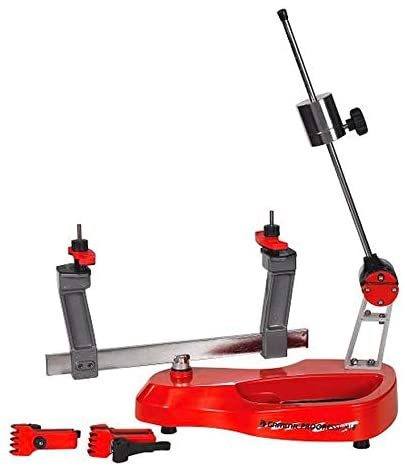
Affiliate Links
Squash Source receives a commission when you buy through these links. Thanks!
Buy (US): amazon.com
Search:The way this type of machine works is there’s a large metal piece on the end of a rod and you slide it up and down the rod to set the tension, then you wind the string and tip the rod over to apply tension using gravity. This also has a “floating clamp” mechanism that I won’t try and explain here but is a little finicky. Overall though, this baby gets the job done.
An Electronic Stringing Machine

Affiliate Links
Squash Source receives a commission when you buy through these links. Thanks!
Buy (US): amazon.com
Search:An electronic machine just pulls the string for you to the correct tension and it’s much more accurate than a drop weight system. The pictured machine also has a fixed clamp system, which is more accurate than a floating clamp style.
My Advice
If you aren’t too sure what string or tension to use, my advice is: don’t worry about it. Just pick something and try it out. The most important thing is to write down the details of how you got it strung, so that if you liked it, you can get it done the same way again, and if you didn’t like it, you can fiddle with the tension or the string next time around. Just commit yourself to learning a little about strings as you go.
String Tension Explained
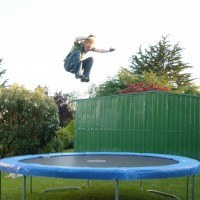
To get more power, string at a lower tension. A string under low tension bends more easily, which sends the ball launching off your strings. Conversely, higher tension gives you a more controlled hit.
The reason is, well, think about it like a trampoline — if it bends easily, it will launch you higher (more power), but the bounce will be more difficult for you to control. Conversely, a stiff trampoline won’t bounce you as high, but it’ll be easier to control your bounces.
String Gauge Explained
Thinner string bends more easily, and that gives you a bit of a power boost. In addition, the thinner the string, the more it will “bite” into the ball on contact, allowing you to put more spin on your shots. Even better, thinner string is a bit lighter, which makes your racket faster through the air, enabling more power and deception on your shots.
So if thinner strings have all these benefits, why not always use the thinnest string available? The reason is that thinner strings are more prone to breakage, which can be expensive and/or annoying to replace.
What Is the Factory String Tension of My Squash Racket?
I get this question frequently so it gets its own answer. Sometimes people will buy a racket and really like the factory setup. Eventually the strings break and they want to duplicate what they had before.
Here’s the thing: it’s really difficult to know what the factory tension was. If you were to buy multiple copies of the same racket, you would often get different string tensions. This is because, as mentioned earlier in the article, factory string jobs are done as cheaply (quickly) as possible without necessarily receiving the attention to detail that a professional restringer would provide.
On top of that, the rackets spend weeks traveling around the world on container ships, where they are exposed to major temperature fluctuations. It’s just one more thing that makes it impossible to say what your factory tension is.
That said: factory string jobs are usually pretty tight. The racket brands want all the strings to be lined up nice and neatly so it looks good in the shop. So if you like your factory string job, you may want to try getting your racket strung at a higher tension like 27 or 28 pounds.
How Much Does It Cost to Restring a Squash Racket?
It usually costs between $25 – $40 to restring a squash racket. A premium string will probably cost around ten dollars more than a budget string.
Here are some professional stringers who have left comments on Squash Source. I might have missed some but will add to this list over time.
You can also get your racket restrung at most clubs or via the online squash retailers.
John says
()
Howdy folks,
Does anyone know what strings Paul Coll been using lately in the 360+ SB? Looks like he switched from the green Eye X Tech to a clear/white string earlier in the year.
Me and a squash buddy have been puzzled trying to figure it out
J says
()
Slow reply but, he uses Kirschbaum Gut Feeling 1.22mm at 24lbs
Sam Hood says
()
Thanks for sharing valuable information on squash strings.
Keep Sharing…
Tor says
()
Maybe someone can help me. Let’s say you have ten meters of both the Ultranick 17 optic green (1.25) and ten meters of Tecnifibre green 305 1.10. Which one has less weight? I have a couple of Harrow Vapors strung up with the mentioned Ultranick, but would like to get some grams of it and make it less head heavy. I assume 305 green 1.10 weighs less since it’s thinner. No idea actually. Anyone?
Tjeerd says
()
Hi Tor,
Purely based on the gauge, you would say that the Tecnifibre 1.10mm string should be lighter than the 1.25 mm Ultranick. However, the construction of these strings is completely different and the core is based on different materials (nylon vs. Zyex).
I cannot find the numbers anymore, but a few year ago, I compared different gauges of similar constructed (braided) nylon strings of different gauges. The difference was only a couple of tenths grams for a complete stringbed. So in short: negligible. 🙂
My guess is that you will have more joy in finding some grams by (partially) cutting the top bumper. And if that’s not enough, go Gaultier style and start shaving you racket with sandpaper. 🙂
Tor says
()
Thanks. I’ll pop out the shaving kit. 😁 Been speculating in buying some lead tape and take the bottom cap of and add some to the inside of the handle. I’m too picky on the grip and can’t add any overgrips cause I have smaller hands.
Tor says
()
I forgot to mention that it’s the balance point I’d like to change the most. Not so important if the weight is 5 grams +/-
And yes you must be right. String gauge can’t have that many grams difference. Anyway; thanks again.
Tjeerd says
()
Seemed that I could do a new measurement after all because I had a set of Ultranick 18 1.15 (blue) laying around. The set is 10m and I chopped 10m from a reel of the thickest braided nylon multi filament I have laying around; Kingut 1.25. Although this is a tennis string, it is perfectly suitable for squash rackets but due to it’s elasticity.
Anyway, the result was:
Ultranick 18 1.15mm : 11.4 grams
Kingut 1.25mm : 13.6 grams
So, a “whopping” 2.2 grams difference. \o/
Thomas Selway Spencer says
()
You’d be surprised how much the strings weigh, and how much 2grams difference makes if it it taken away or added to the head.
I have a micro measurer and a bunch of strings/guages which I may weigh and post.
However, I would personally not tamper with the bumper or the racket itself – you will adversely affect string durability far more than going thin on your string.
Remember to drop your tension by at least 1lb for every .5mm guage you reduce. For instace if I strung a bed at a guide/avg tension of 27lbs in 1.2 string, I would string 1.1 at 24.5 or lower, otherwise you will have a far to tight feeling bed. This is because of how much more the string will stretch under the same tension. Crudely, if I stretched 5metres of 305 1.2mm at 27lbs it would elongate by 1metre. If I did the same to 1.1mm it would elongate by 2metres and be tighter than the 1.2. The flexibility of the thinner string is negated by the greater elongation.
There is such a change in feel with changing guage, that it needs a little experimentation to get right for you. Costly if you are paying a good stringer to work with you. However, we can adjust to most changes over time.
I would personally stick with what you’ve got and open of the butt cap and pump in about 2grams of bathroom silicone. or get 3grams of lead tape and wrap it on the handle where your middle finger wraps around. This is a good balancing point for making things head lighter.
Borja says
()
Hi, the easiest way to change the balance of your racquet is by adding weight to the grip. Even if you add weight there, you will feel the lightest racket. Try putting two grips on it, one on top of the other and you will see how the sensations change. When you get the feel you like, weigh the added grip. Then you take out the lower cover of the grip, put the weight you want and reassemble it. You will have the original grip and your balance will have changed. Although you find added weight, the feeling will be the opposite. I hope it is understood, I am using a translator. Cheers
Tor says
()
Yeah thanks. Understood. 😊 I have been experimenting with grips for sure. Last time now I used most of the grip’s length by adding it little higher than normal to the frame. Also I tried wrapping it gently without stretching it too much. It makes a difference.
Andrei Breslavski says
()
I pull my racket 24lbs horizontal and 26lbs vertical. How do you pull on your racket?
Rob says
()
To go under the Oliver link (that is not showing)
https://www.oliversport.co.uk/product/sq-x5-200m/
Bill williams says
()
Hi Pierre have you seen the Ashaway oblivion 18/17 hybrid stings ? Can’t find a review anywhere
Thomas says
()
The cross string is just supernick xl 1.25 without the flecks of blue and red running through.
It is a lot cheaper to buy a set of powernick and supernick and try hybriding them.
make the powernick lower tension by 2-4lbs, as it is a stiff string which requires less tension. It will also move MORE if it is the tighter string (weird right?). It is the tighter crosses which work better to lock in the mains and top them from moving. As it is a two-piece, if the mains are tighter, they will dominate the tension against the crosses and be allowed to move more.
I’ve tried the oblivion as was sent demo sets a couple of years ago. I personally think that just using supernick a little tighter (and still dropping the mains tension by a 1lb, even when strung in1-piece, is a more consistent bed than the hybrid product. But, you should try it, as fell is in the hadns of the beholder.
John says
()
I know the best two makes for strings are Tecnifibre and Ashaway .. but does anyone use string made from your racket manufacturer? Example I alternate between a Prince ExO3 Rebel and Tecnifibre Carboflex 130S .. the Prince had the signature green Prince synthetic gut 17g, whilst the Carboflex has the legendary 305+ 17g string in it. Honestly I hit fine with both as is (or was). I just recently cut out the synthetic gut and put in Tecnifibre X-One Biphase 18g on the rebel and took it out on the court last night and I was just off with it all night. I felt I was hitting better with the old strings in it. Maybe I just need to get used to it more for it to feel like the same old trusty rebel it was. But does anyone use strings aside from Tecnifibre or Ashaway? Ramy plays with Prince, does anyone know if he uses Prince strings as well?
Appreciate the feedback in advance! Cheers
Jay says
()
Ramy always uses the Tecnifibre 305 green strings from what I’ve seen.
I’ve always kept and enjoyed the factory strings on my Xamsa racquets. They’ve never broke on me and I find that I get good power and cut from them. Otherwise, I usually use Ashaways (found and bought some half-reels for cheap) because I’ve found that factory strings are usually crap (Dunlop, Prince, Head, Karakal). Just my opinion as I’m no expert.
Pierre says
()
Like Jay said, Ramy uses the 305 green. I’ve tried Gamma and Head strings before (in addition to all the factory strings) and I’ve liked some of those. Some pros also use a brand called RAB I think — but I’ve never tried it. Strings are something of a mystery to me. I don’t really have a go-to option, I just keep trying different setups and hoping one day a grand unified theory of squash strings will pop into my head.
Greg says
()
It looks like Technifibre 17g, but happy to stand corrected on that…
Antoine says
()
Good morning squash lovers,
The Harrow strings section is not available. I tried on a few occasions the Barrage Pro strings and it feels really close to me to Ashaway style strings.
Is there a reason those strings aren’t used that much?
Thanks
Pierre says
()
Thanks for the reminder Antoine. I’ve added a Harrow strings page now with just Barrage Pro on there for the moment.
Harrow rackets used to come strung with Ashaway so I think they probably worked with Ashaway’s manufacturer to come up with their own branded line of strings.
JB says
()
Lawrence sorry didn’t see your question till now. Using a Slimbody speed at 19 and works well. Plenty of power and for touch stays in contact a bit longer doesn’t just fly off the strings like at higher tensions. Our clubs best player strings at 17. I switch back and fourth between 305 18g and x-one.
JvN says
()
I’ve started stringing my rackets with Sufix PU Multifibre 1.27, 17 Gauge strings. Has a similar construction to the Tecnifibre 305 but less than half the price (works out at 160 ZAR, that’s about $13). Works pretty well for my style of game, it allows me to generate massive spin, it has enormous consistency keeping it’s tension but with time they soften up instead of loosing that tension. Power is moderate, control good and you feel the ball on them pretty well. My last stringing was 25lbs on my Wilson Pro Staff NTour, will probably string it next time to 24lbs to see how they perform as I found that 25lbs was a small touch too tight for my liking. PS. Really enjoy Squash Source, great blog and Youtube channel. Keep up the good work.
Pierre says
()
Thanks, never heard of that! https://www.string-along.co.za/p/633022/suffix-pu-multifiber-17